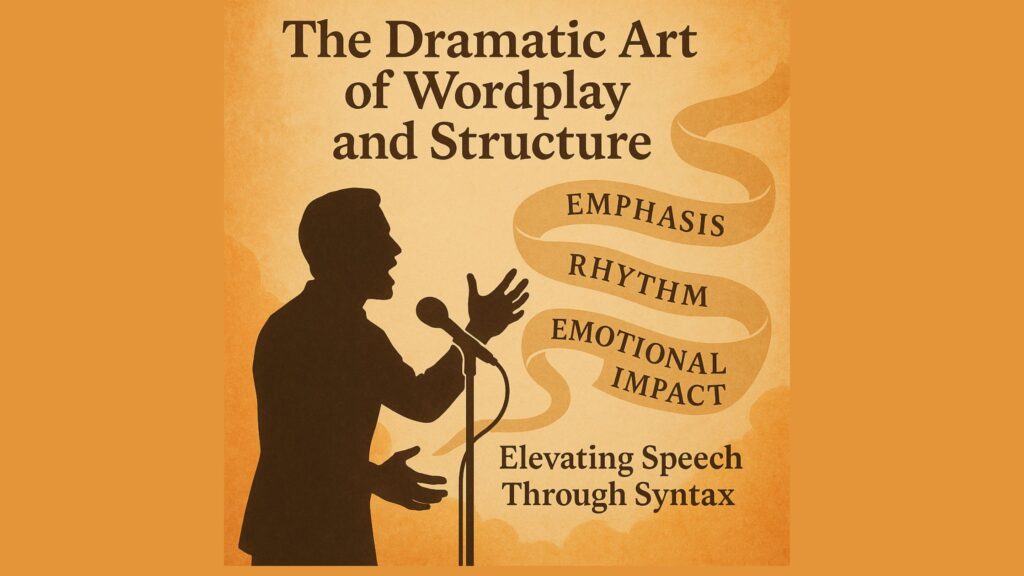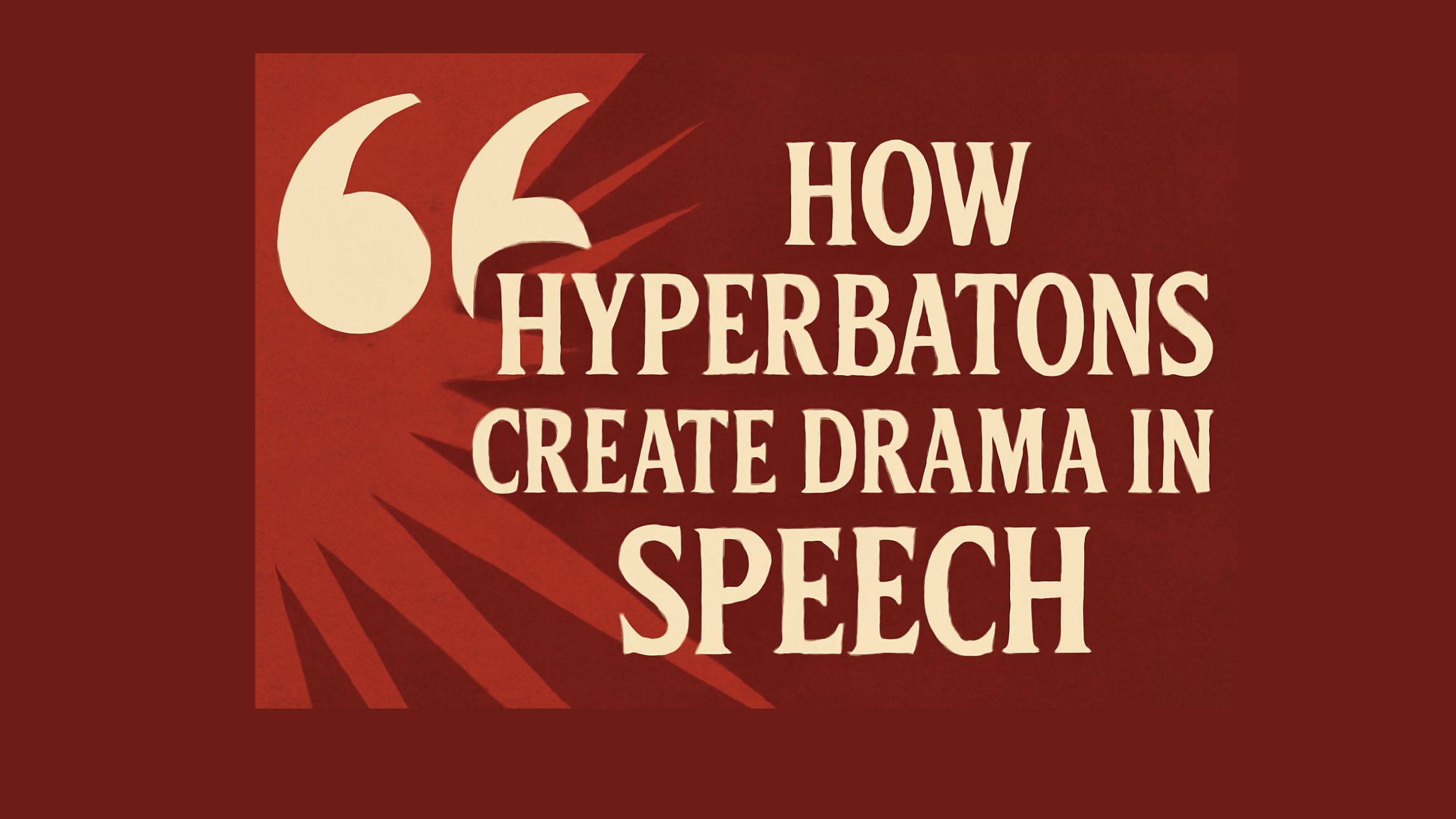Have you ever listened to a speech and felt the words stir something deep inside you? That emotional impact often comes from rhetorical techniques like hyperbatons. In this article, we’ll discuss how hyperbatons create drama in speech by rearranging words for emphasis. This technique helps speakers create suspense, highlight emotions, and make their message unforgettable. Read on to learn how you can harness the power of hyperbatons in your own communication.
What is a Hyperbaton? (Understanding the Basics)
The Definition and Etymology of Hyperbaton
To understand how hyperbatons create drama in speech, it’s important to first know what a hyperbaton is. A hyperbaton is a rhetorical device where the normal order of words is intentionally changed to add emphasis, rhythm, or dramatic effect. The word comes from the Greek term hyperbaton, meaning “stepping over” or “transposition.” It’s a stylistic twist that breaks the expected flow of language, often seen in poetry, speeches, and literature.
This technique allows speakers and writers to highlight certain words or phrases by placing them in unusual positions. It’s not about breaking grammar rules, but rather bending them for creative impact. Whether it’s to stress a feeling or create a pause for effect, hyperbatons bring a unique flavor to spoken or written expression.
Difference Between Hyperbaton and Other Rhetorical Devices
While hyperbaton changes word order for emphasis, it’s different from other rhetorical devices like anaphora or antithesis. Anaphora involves repeating words at the beginning of sentences, while antithesis places opposing ideas side by side. Hyperbaton stands out because it rearranges words within a sentence, not across multiple lines.
For example, instead of saying “I cannot go,” one might say, “Go, I cannot,” to shift focus and tone. This subtle reordering gives hyperbatons a dramatic edge that other rhetorical tools don’t quite deliver. It’s this distinct quality that helps explain how hyperbatons create drama in speech, especially when clarity and emotion are equally important.
Why Word Order Matters in Language and Rhetoric
In everyday communication, word order shapes meaning. That’s why when someone changes the natural sequence, it immediately catches attention. How hyperbatons create drama in speech is closely tied to this principle. By moving words around, the speaker plays with the listener’s expectations—creating tension, emphasis, or even surprise.
In rhetoric, this control over structure is powerful. It’s not just what is said, but how it’s said that leaves an impression. A hyperbaton disrupts predictability, forcing the audience to pause, think, and feel. It turns simple messages into memorable statements—making language not just functional, but expressive and dynamic.
The Psychological Impact of Hyperbatons on Listeners

How Unexpected Word Order Grabs Attention
Understanding how hyperbatons create drama in speech starts with knowing how our brains react to surprise. When a sentence doesn’t follow the usual word order, the listener’s attention is instantly heightened. This sudden change in structure disrupts routine processing, making the message stand out more clearly in the mind.
Hyperbatons act like verbal speed bumps—they force the brain to slow down and take notice. That small pause can be powerful, especially in speeches or storytelling, where attention is everything. Listeners subconsciously lean in, eager to grasp the meaning behind the shifted words.
Emotional Emphasis Through Disruption
Hyperbatons don’t just attract attention—they also create emotion. By reordering words, speakers can highlight the most important or emotional parts of a sentence. This disruption shakes up the normal flow, causing the listener to feel more deeply.
Instead of saying “I am afraid,” using “Afraid, I am” can express vulnerability more intensely. It’s the same words, but the drama and weight shift. That’s the secret to how hyperbatons create drama in speech—they change not just structure, but feeling.
Examples of Hyperbatons That Stir Emotion
Many famous lines use hyperbatons to stir emotion and stick in memory. Here are a few examples that show how hyperbatons create drama in speech:
- “This I must see.” (Instead of “I must see this.”)
- “Deep into that darkness peering, long I stood there wondering, fearing…” – Edgar Allan Poe
- “Sweet she was.” (Instead of “She was sweet.”)
These phrases linger because the unexpected word order triggers both thought and feeling. Whether in poetry, speeches, or storytelling, hyperbatons bring an emotional edge that traditional phrasing often lacks.
How Hyperbatons Create Drama in Speech
Suspense and Delay: The Power of Pauses
One of the key reasons how hyperbatons create drama in speech lies in their ability to introduce suspense. By rearranging word order, speakers can delay key information, which builds tension and curiosity. This pause, even if brief, gives the audience time to anticipate what’s coming next.
For example, saying, “To the end, we must go,” instead of “We must go to the end,” holds the audience in slight suspense. It’s a subtle shift, but it makes the message more gripping. The delay gives weight to the conclusion, adding drama without changing meaning.
Rhythm, Tension, and Impact in Public Speaking
In public speaking, rhythm and pacing are crucial—and hyperbatons naturally create both. When the expected word order is disrupted, the brain pauses for interpretation. This not only grabs attention but also adds rhythm and emotional tension to the sentence.
This technique explains how hyperbatons create drama in speech—they slow the pace just enough to add weight to key phrases, making delivery more memorable. For speakers, it’s a tool to emphasize their message without shouting or exaggeration.
Famous Speeches That Used Hyperbatons Dramatically
Many iconic speeches throughout history have shown how hyperbatons create drama in speech by using unusual word order to stir emotion and leave a lasting impact.
- Martin Luther King Jr.: “Free at last, free at last, thank God Almighty, we are free at last!”
- Winston Churchill: “Into the jaws of death, rode the six hundred.”
- Yoda (fictional but famous): “Powerful you have become.”
These examples show that when words are shifted purposefully, they don’t confuse—they captivate. Hyperbatons turn ordinary language into unforgettable lines.
Hyperbatons in Literature, Film, and Media
Shakespeare, Yoda, and the Drama of Rearranged Syntax
To truly understand how hyperbatons create drama in speech, one only needs to look at two iconic figures—Shakespeare and Yoda. Both used unusual sentence structures that made their words unforgettable. Shakespeare’s poetic lines often played with word order to emphasize love, power, or tragedy. Think: “Some rise by sin, and some by virtue fall.”
Yoda, from Star Wars, made rearranged syntax his trademark. His lines like “Powerful you have become” stick in memory because they break the norm. This creative twist makes the message sound wiser, deeper, and more dramatic.
Hyperbatons in Screenwriting and Dramatic Dialogue
In modern film and TV, hyperbatons are used subtly to shape how characters speak. This shows how hyperbatons create drama in speech by giving characters a unique voice or adding emotional punch. Writers often place key words at the beginning or end of a sentence to increase impact.
For instance, instead of “You ruined everything,” a character might say, “Everything—you ruined.” That shift adds tension and makes the line feel more emotional and confrontational. It’s small but powerful, perfect for dramatic moments.
How Writers Use Syntax to Drive Emotion and Tone
Writers understand that how hyperbatons create drama in speech comes down to control—control over pacing, tone, and feeling. By playing with syntax, they guide the reader’s or viewer’s emotional journey. A restructured sentence can soften anger, highlight sadness, or build suspense.
Hyperbatons slow down the reader, drawing attention to specific words. This technique adds texture to writing, making it more expressive. In both novels and screenplays, changing word order isn’t just artistic—it’s strategic. It shapes how the message feels, not just what it says.
When and Where to Use Hyperbatons Effectively
Best Practices in Speechwriting and Storytelling
Knowing how hyperbatons create drama in speech is helpful, but using them effectively is even more important. In speechwriting and storytelling, hyperbatons are best used to highlight emotion, create suspense, or add a poetic touch. Writers and speakers should use them where the goal is to capture attention or emphasize a turning point.
For example, placing a strong word at the beginning of a sentence can immediately hook the audience. In stories, rearranging words can add rhythm and emotion, especially during key moments of dialogue or narrative tension.
The key is to use hyperbatons with purpose, not just style.
Avoiding Overuse: Clarity vs. Complexity
While how hyperbatons create drama in speech is undeniable, using them too often can confuse the audience. Overuse can lead to awkward phrasing or make the message feel forced. It’s essential to balance creativity with clarity.
Writers should ask: Does the reordered sentence sound natural? Does it support the message? If not, simplicity is better. Hyperbatons work best when they add value, not when they distract. Effective communication always comes first—even when drama is the goal.
Hyperbatons in Marketing and Persuasive Copywriting
Marketers also understand how hyperbatons create drama in speech—especially in persuasive copywriting. A cleverly placed hyperbaton can break monotony and draw attention to a product’s benefit or emotional appeal.
Instead of saying, “You’ll love our new formula,” a brand might say, “Love it, you will.” It sounds fresh and memorable. Hyperbatons can make ads, headlines, and taglines stand out by adding rhythm or surprise—turning a simple sentence into something sticky.
Used sparingly, they can turn plain messages into persuasive calls to action.
Conclusion: The Dramatic Art of Wordplay and Structure
Why Hyperbatons Are More Than Just Fancy Grammar
Hyperbatons are far from just a quirky grammar trick. They are a powerful tool in speech and writing, allowing speakers and writers to break conventional word order for emphasis, rhythm, and emotional impact. This technique turns ordinary statements into dramatic, unforgettable phrases that captivate audiences.
Final Thoughts on Elevating Speech Through Syntax
By mastering how hyperbatons create drama in speech, one can elevate the emotional depth of their communication. Whether in public speaking, storytelling, or persuasive writing, hyperbatons help emphasize key ideas, build suspense, and make every word count. This artful manipulation of word order adds both texture and intensity, proving that sometimes, the best way to get a message across is by stepping outside the expected.

